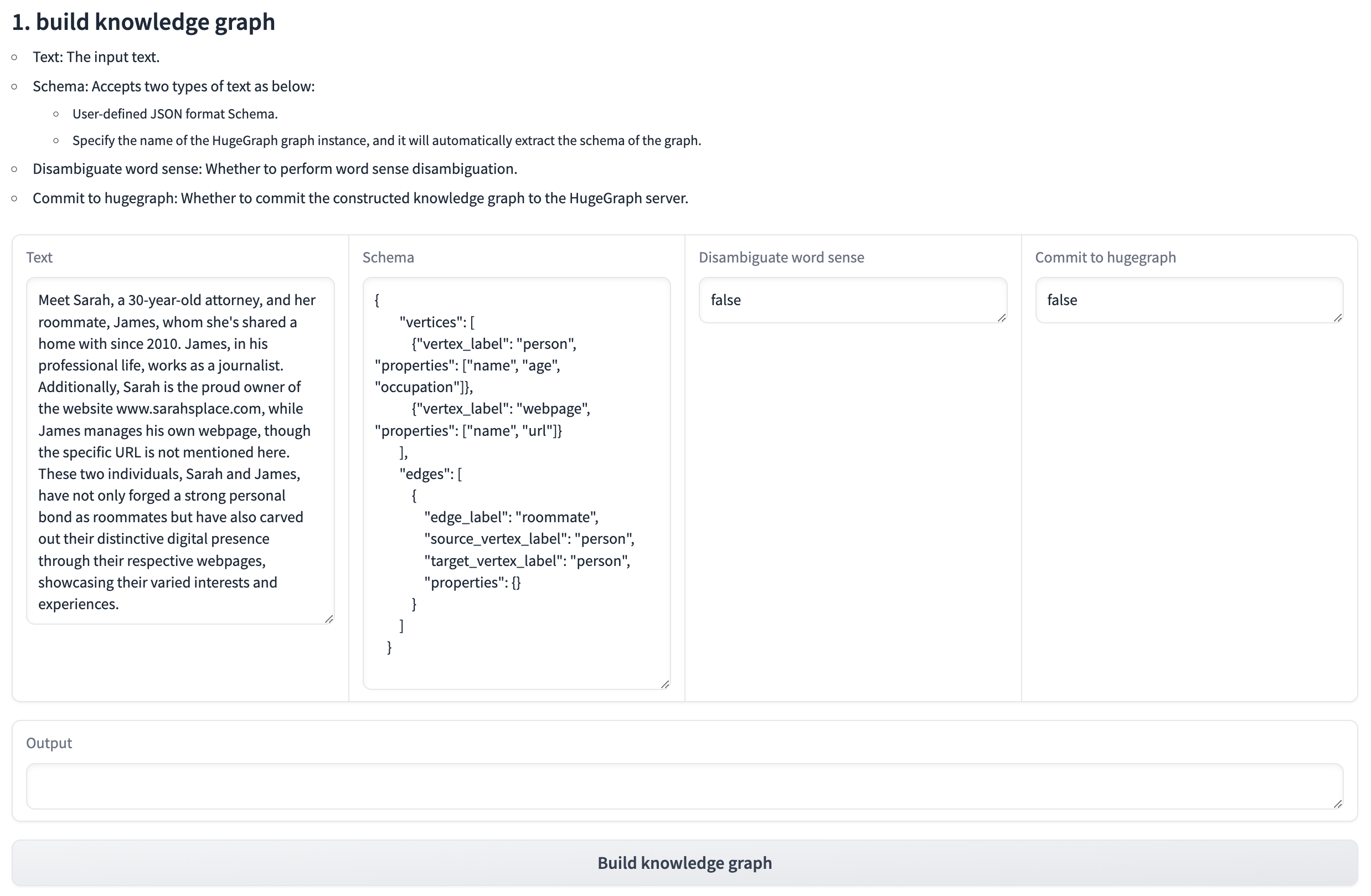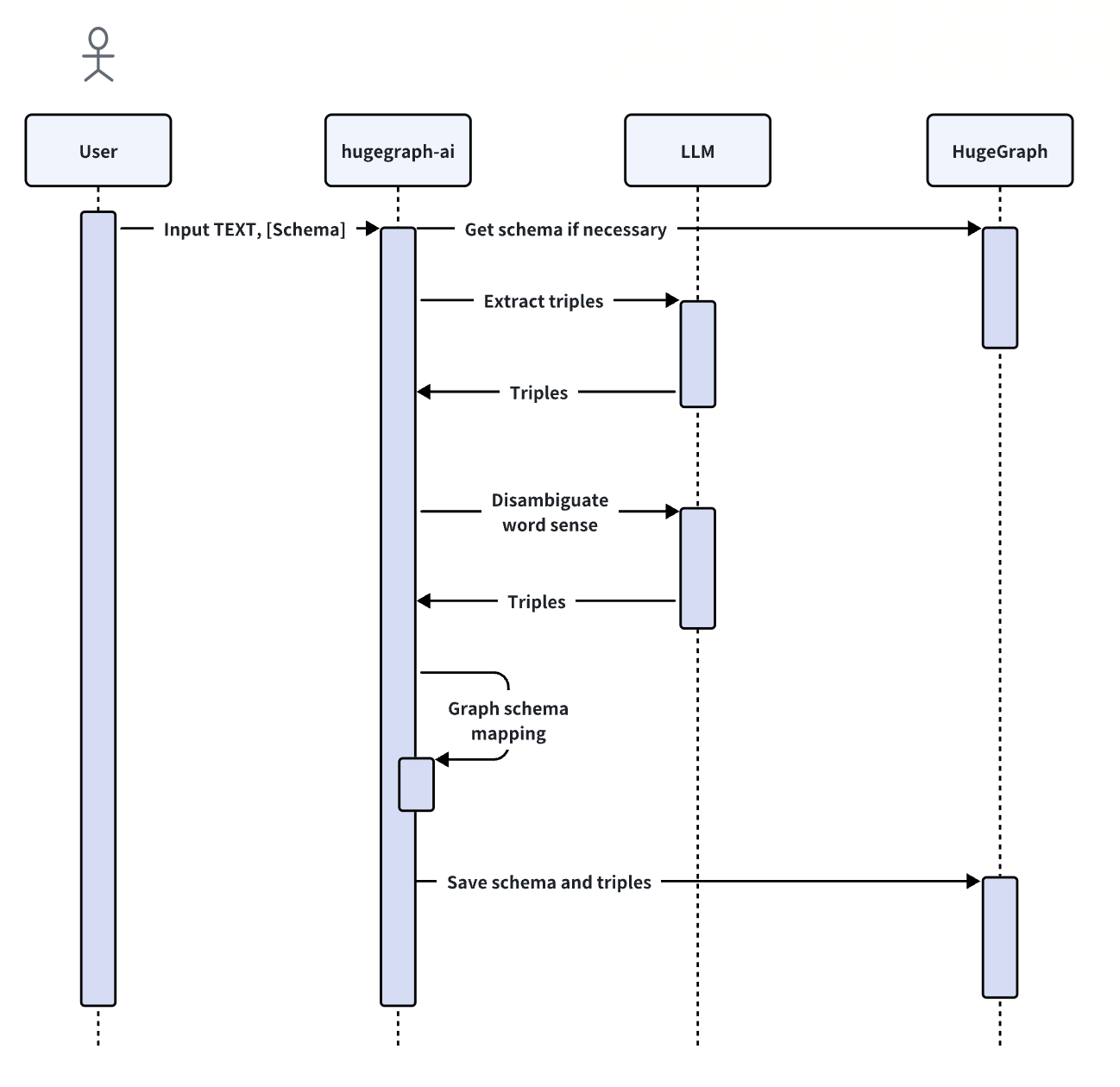The hugegraph-llm is a tool for the implementation and research related to large language models.
This project includes runnable demos, it can also be used as a third-party library.
As we know, graph systems can help large models address challenges like timeliness and hallucination, while large models can help graph systems with cost-related issues.
With this project, we aim to reduce the cost of using graph systems, and decrease the complexity of building knowledge graphs. This project will offer more applications and integration solutions for graph systems and large language models.
- Construct knowledge graph by LLM + HugeGraph
- Use natural language to operate graph databases (Gremlin/Cypher)
- Knowledge graph supplements answer context (GraphRAG)
- python 3.9+ (better to use
3.10) - hugegraph-server 1.3+
-
Start the HugeGraph database, you can run it via Docker/Binary Package.
Refer to detailed doc for more guidance -
Clone this project
git clone https://github.com/apache/incubator-hugegraph-ai.git
-
Install hugegraph-python-client and hugegraph_llm
cd ./incubator-hugegraph-ai # better to use virtualenv (source venv/bin/activate) pip install ./hugegraph-python-client && pip install -r ./hugegraph-llm/requirements.txt
-
Enter the project directory
cd ./hugegraph-llm/src -
Start the gradio interactive demo of Graph RAG, you can run with the following command, and open http://127.0.0.1:8001 after starting
python3 -m hugegraph_llm.demo.rag_demo.app
The default host is
0.0.0.0and the port is8001. You can change them by passing command line arguments--hostand--port.python3 -m hugegraph_llm.demo.rag_demo.app --host 127.0.0.1 --port 18001
-
After running the web demo, the config file
.envwill be automatically generated at the pathhugegraph-llm/.env. Additionally, a prompt-related configuration fileconfig_prompt.yamlwill also be generated at the pathhugegraph-llm/src/hugegraph_llm/resources/demo/config_prompt.yaml. You can modify the content on the web page, and it will be automatically saved to the configuration file after the corresponding feature is triggered. You can also modify the file directly without restarting the web application; refresh the page to load your latest changes.
(Optional)To regenerate the config file, you can useconfig.generatewith-uor--update.python3 -m hugegraph_llm.config.generate --update
-
(Optional) You could use hugegraph-hubble to visit the graph data, could run it via Docker/Docker-Compose for guidance. (Hubble is a graph-analysis dashboard include data loading/schema management/graph traverser/display).
-
(Optional) offline download NLTK stopwords
python ./hugegraph_llm/operators/common_op/nltk_helper.py
Parameter description:
- Docs:
- text: Build rag index from plain text
- file: Upload file(s) which should be TXT or .docx (Multiple files can be selected together)
- Schema: (Except 2 types)
- User-defined Schema (JSON format, follow the template to modify it)
- Specify the name of the HugeGraph graph instance, it will automatically get the schema from it (like "hugegraph")
- Graph extract head: The user-defined prompt of graph extracting
- If it already exists the graph data, you should click "Rebuild vid Index" to update the index
The KgBuilder class is used to construct a knowledge graph. Here is a brief usage guide:
-
Initialization: The
KgBuilderclass is initialized with an instance of a language model. This can be obtained from theLLMsclass.
Initialize the LLMs instance, get the LLM, and then create a task instanceKgBuilderfor graph construction.KgBuilderdefines multiple operators, and users can freely combine them according to their needs. (tip:print_result()can print the result of each step in the console, without affecting the overall execution logic)from hugegraph_llm.models.llms.init_llm import LLMs from hugegraph_llm.operators.kg_construction_task import KgBuilder TEXT = "" builder = KgBuilder(LLMs().get_chat_llm()) ( builder .import_schema(from_hugegraph="talent_graph").print_result() .chunk_split(TEXT).print_result() .extract_info(extract_type="property_graph").print_result() .commit_to_hugegraph() .run() )
-
Import Schema: The
import_schemamethod is used to import a schema from a source. The source can be a HugeGraph instance, a user-defined schema or an extraction result. The methodprint_resultcan be chained to print the result.# Import schema from a HugeGraph instance builder.import_schema(from_hugegraph="xxx").print_result() # Import schema from an extraction result builder.import_schema(from_extraction="xxx").print_result() # Import schema from user-defined schema builder.import_schema(from_user_defined="xxx").print_result()
-
Chunk Split: The
chunk_splitmethod is used to split the input text into chunks. The text should be passed as a string argument to the method.# Split the input text into documents builder.chunk_split(TEXT, split_type="document").print_result() # Split the input text into paragraphs builder.chunk_split(TEXT, split_type="paragraph").print_result() # Split the input text into sentences builder.chunk_split(TEXT, split_type="sentence").print_result()
-
Extract Info: The
extract_infomethod is used to extract info from a text. The text should be passed as a string argument to the method.TEXT = "Meet Sarah, a 30-year-old attorney, and her roommate, James, whom she's shared a home with since 2010." # extract property graph from the input text builder.extract_info(extract_type="property_graph").print_result() # extract triples from the input text builder.extract_info(extract_type="property_graph").print_result()
-
Commit to HugeGraph: The
commit_to_hugegraphmethod is used to commit the constructed knowledge graph to a HugeGraph instance.builder.commit_to_hugegraph().print_result()
-
Run: The
runmethod is used to execute the chained operations.builder.run()
The methods of the
KgBuilderclass can be chained together to perform a sequence of operations.
The RAGPipeline class is used to integrate HugeGraph with large language models to provide retrieval-augmented generation capabilities.
Here is a brief usage guide:
- Extract Keyword: Extract keywords and expand synonyms.
from hugegraph_llm.operators.graph_rag_task import RAGPipeline graph_rag = RAGPipeline() graph_rag.extract_keywords(text="Tell me about Al Pacino.").print_result()
- Match Vid from Keywords: Match the nodes with the keywords in the graph.
graph_rag.keywords_to_vid().print_result()
- Query Graph for Rag: Retrieve the corresponding keywords and their multi-degree associated relationships from HugeGraph.
graph_rag.query_graphdb(max_deep=2, max_graph_items=30).print_result()
- Rerank Searched Result: Rerank the searched results based on the similarity between the question and the results.
graph_rag.merge_dedup_rerank().print_result()
- Synthesize Answer: Summarize the results and organize the language to answer the question.
graph_rag.synthesize_answer(vector_only_answer=False, graph_only_answer=True).print_result()
- Run: The
runmethod is used to execute the above operations.graph_rag.run(verbose=True)

